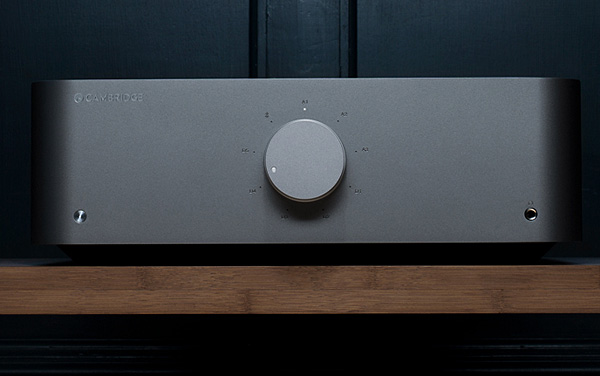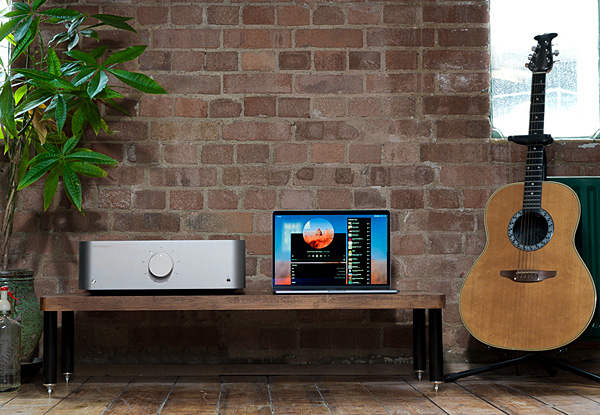| Columns Retired Columns & Blogs |
May be KM or HR or JA could keep this Cambridge Edge A around for a while and review some of the 'affordable' loudspeakers under $5,000 or even under $10,000 :-) ............
Use the dial behind the volume dial to gently click through the Edge A's digital and analog source options: D1, D2, D3, D4, D5, Bluetooth, A1, A2, A3. In the faceplate's lower left corner is the Standby/On button, and at lower right is the ½" headphone jack.
On the rear panel are, from left to right: the AC power socket (cord included), and above it the right-channel speaker posts; a voltage selector switch ("For use by Cambridge Audio service personnel only!" warns the manual); the right-channel preamp output (XLR, RCA) and input (XLR, A3), right- and left-channel input pairs (RCA, A1 and A2), left-channel input (XLR, A3), and left-channel pre-out (XLR, RCA). Above the analog jacks, from left to right, are the USB Class 2 audio input, HDMI input Audio Return Channel (for connection to a TV that supports ARC), three digital inputs (one coax, two USB), and a Bluetooth antenna; below the antenna are the left-channel speaker posts. Running along the bottom right of the rear panel are an Auto Power Down switch (to override the Edge A's annoying but EU-required technology that demands powering down if the volume falls below a minimum threshold for 20 minutes), Link In and Out 3.5mm jacks for connection to an Edge W power amplifier, and an RS-232 custom-installation port.

Setup
I recently moved my Thorens TD 124 Mk.I turntable with Jelco 350S tonearm and Ortofon Quintet Bronze cartridge into my main rig, to drive the very refined Luxman EQ-500 tubed phono preamplifier. I connected the Luxman to the Edge A with a pair of Triode Wire Labs American Spirit interconnects. An ATC CDA2 Mk.II CD player met the Edge A via Auditorium XLR-to-RCA links. Auditorium 23 speaker cables joined the Edge A to my DeVore Fidelity Orangutan O/93 speakers.
Listening
The Thorens TD 124 Mk.I with Jelco arm has a generally lighter sound than my Kuzma Stabi S turntable and Stogi arm, but it well suited the Luxman phono preamp and the Cambridge Edge A. I was struck by this combo's shimmering, translucent, finely detailed upper midrange to treble frequencies.
There was no confusing the sound of the solid-state Edge A with that of a tubed integrated amplifier. Octave Audio's V 80 SE tubed integrated, which I reviewed in September 2017, had struck a clear balance between tube bloom and solid-state grip, its sound owing no particular allegiance to either camp—but the Edge A's sound was pure solid-state, of the silk-ear variety. Through the Edge A and Luxman EQ-500, LPs were studies in upper-harmonic sheen and nth-degree tonal shadings between different notes, different instruments, and even different pressings. Whether I listened to rocker Tom Petty, atmospheric jazz combo Bass Desires, master double bassist Dave Holland, or violin virtuoso David Oistrakh, vinyl was sweetly delineated through the Cambridge-Luxman combo.
I recently came into a large collection of dub and reggae records. One LP that sounded fantastic through the Edge A was drummer Sly Dunbar's Sly, Wicked and Slick (LP, Taxi/Virgin FL1042). Not all reggae records are created equal or are well recorded, and some from the 1980s are just shinily produced pop drivel. But Sly, Wicked and Slick is a feast of outsize production, with myriad electric instruments spread across a good-sized soundstage, powered by Dunbar's cross-hemispheric tom drops and driving bass drum. Where my Shindo Laboratory Haut-Brion power amp presents Dunbar's ever-present four-to-the-bar bass drum like a giant wet orange packed with color and humidity, the Edge A laid it out as clean and round, a little dry, the edges highlighted, with less bass depth. The Cambridge reproduced the long bass-drum notes without the dense color saturation of costlier tube gear. Still, when Dunbar drove his bass drum hard, I missed nothing; instead, I enjoyed the drum's singularly clean, crisp punches to my skull. The Edge A was consistently crisp, instruments fully realized, every sonic gradation of every recording fully present.

The Edge A produced some of the best soundstaging I've heard in my apartment: deep and wide, with excellent retrieval of micro- and macrodetail. The Edge A dove deep into Marc Johnson's Second Sight (LP, ECM 1351). Johnson's wiry double bass was amply defined in space, but the actual weight of the soundstage—the physical presence of this musical thunderstorm—was even heavier than his instrument. The Cambridge-Luxman pairing recreated all of this disc's intensity and splendor, leaving nothing to the imagination.
Slipping Christian McBride's New Jawn (CD, Mack Avenue MAC 1133) into the ATC CDA2 Mk.II restored some of the low-end weight I was missing with LPs, while sacrificing only a dab of vinyl's gossamer treble richness. McBride's double bass sounded downright sticky, albeit with a kind of one-tone signature. Music became more tactile and immediate via CD, with good treble focus and energy and more bass weight. John Scofield's Combo 66 (CD, Verve 678 021 3) was similarly enhanced from the midrange down, Bill Stewart's cymbals and drums finely hewn. Qobuz streams, too, sounded crystalline and pure through the Edge A's own DAC, the service's CD-resolution fare offering endless fun.
The Edge A performed a largely neutral role, revealing the humanity of vinyl via the Luxman, and the greater low-end punch of CDs through the ATC, all through an aural lens of absolute clarity, sweet tonality, better-than-average spatial reproduction of instruments and recording venues, and good bass performance. As for that last quality, the massive, wet, monsoon-like electric-bass notes I heard from Pat Metheny's Secret Story (CD, Geffen GED 24468) confirmed the superiority of the Edge A's control of the DeVore O/93's 10" woofers in my Manhattan crib space. The vise-like grip the Edge A maintained on the DeVores' woofers exceeded that of any other integrated amp I've heard.
I'd listened to percussionist Kjell Tore Innervik's Utopias (SACD/CD, 2L 2L-141-SABD) many times, but always dismissed these works—Xenakis's Psappha and Feldman's The King of Denmark—as intellectual exercises in contemporary classical music. Not so through the Edge A. Now the ascending and descending lines on toms, bells, and assorted percussion spoke to me clearly, with power and tone. I could feel the densities of hands and mallets on drumheads, the spaces between notes that create drama, scale, and musical flow. Perhaps it was the Edge A's lack of capacitors in the signal path that allowed it to run faster and jump higher, its speed and swiftness helping to bring me closer to the music on this recording than ever before.
Summing Up
I've reviewed many integrated amplifiers for Stereophile. Heck, Herb Reichert and I may together hold the record for most integrateds reviewed in a single year. None has provided me with as much simple, exuberant, at times jaw-dropping fun as Cambridge Audio's Edge A. Totally satisfying, and capable of getting the best out of LPs, CDs, and streams, the Edge A provided a funhouse of music enjoyment, bringing fresh light to old discs and new discoveries with every medium. Granted, I provided very good components upstream, to challenge the Edge A to dig deep. But when an amp can so effectively reveal the true nature of its accompanying components, bringing to the party clarity, spaciousness, good tone, and solid drive, I'd say it's worth your time and your $5000.

May be KM or HR or JA could keep this Cambridge Edge A around for a while and review some of the 'affordable' loudspeakers under $5,000 or even under $10,000 :-) ............

Welcome to 21st century :-) ...........

The headphone output impedance of 10 ohms is not low. It's high enough to interfere with the sound quality of efficient headphones. By way of example, the Schiit Magni 3 headphone amp has an output impedance of 0.6 ohms.

Agreed ........ All the portable Chord self-powered head-amp/DACs like Mojo, Hugo2 and Hugo TT2 have headphone output impedance less than 1 Ohm .......... Rogue RH-5 (Stereophile Class-A) has head-amp output impedance between 1-3 Ohms .......... 10 Ohm output impedance can drive top of the line Sennheiser and Focal headphones and some others with high impedance :-) ............

"The CD1 two-box CD player ... was the most expensive CD player in the world at the time." - sounds like misinformation, to say the least.

https://www.whathifi.com/features/best-24-cd-players-what-hi-fis-lifetime
"[In 1986] Cambridge Audio's CD1 cost a fortune at £1500. Double, if not triple, most other players."

Technics SL-P50P - 1984 - $4000. I'm pretty sure there's more examples.

An amp that turns itself off after a few seconds with a fault doesn't sound like fun to me. Especially not at this price point.
Last time Stereophile tested a flagship CA integrated (the 851), the first sample broke and the second was faulty. This time the first one broke.
On this evidence, isn't JA being generous with his assumption that the shipper was at fault? Seems like a bit of a trend is developing, slightly worrying on what are not cheap items.
Personally, at this price I'd be looking at items manufactured in-house, not outsourced to China.
Thanks for a great magazine, by the way.

What did you expect? It's MADE IN CHINA.

....demand that any hi-fi (possibly any electronic device) unit running a negligible signal for more than 20 minutes must power down. And it's easily defeat-able; I was only making note that it's bothersome.
Beyond the issues that greeted JA after I had the CA in house, build quality was excellent, the unit worked perfectly, and sounded fantastic, never mind where it was manufactured.

"A few seconds after I first powered up Ken Micallef's review sample of the Edge A..... it turned itself off, its front-panel light glowing red to indicate a fault" says JA.
What's that got to do with "Brit" regulations, and how is it defeatable?
And build quality was excellent, the unit worked perfectly, and it broke and had to be replaced.
Gotcha!

May be you (KM) could review one of the ATC self-powered active loudspeakers, preferably with the ATC CD player/pre-amp, you recently reviewed? :-) ..........

Ken mentioned this is the best integrated that he's auditioned. And I see that is not a small number in the past few years. Is this piece really more impressive than the Luxman? I ask because I'm demoing it right now. My old Krell KAV300i is getting long in the tooth and I was looking for something a bit more refined. IMO, this is a really nice piece; well defined sound and easy to listen to for long periods.